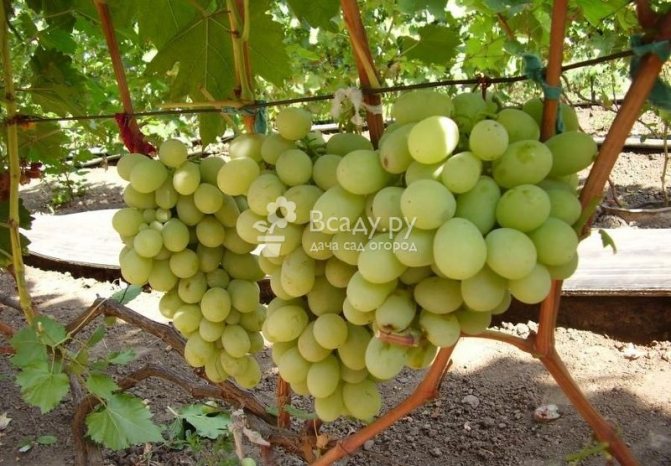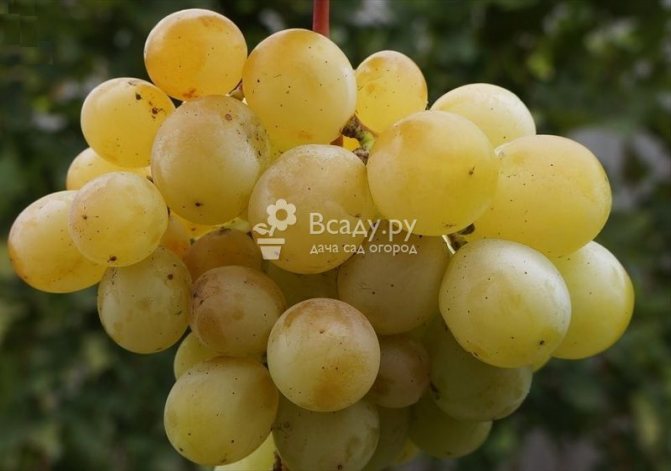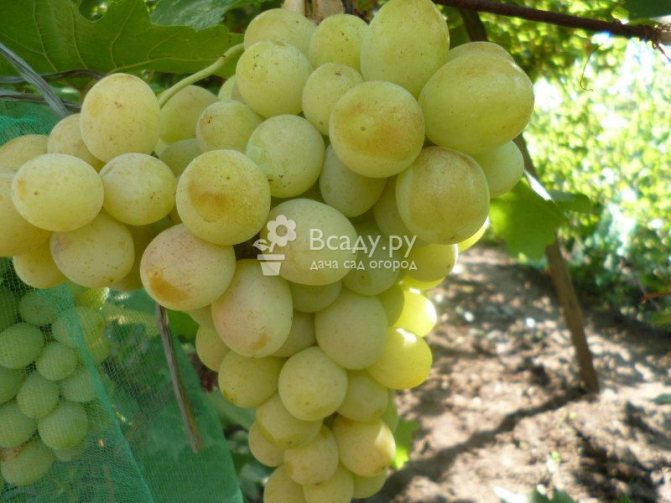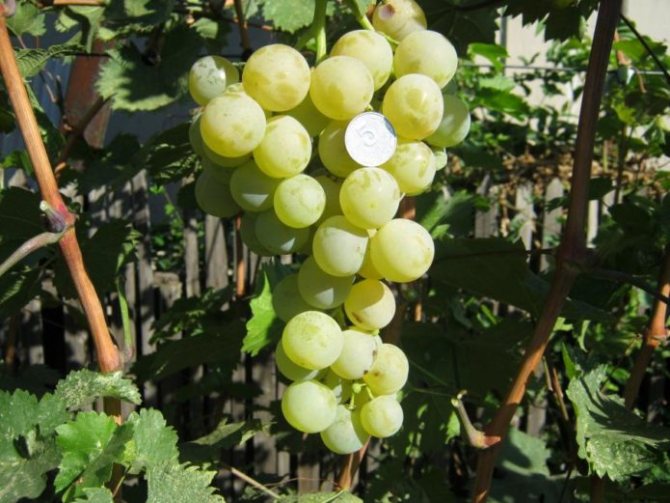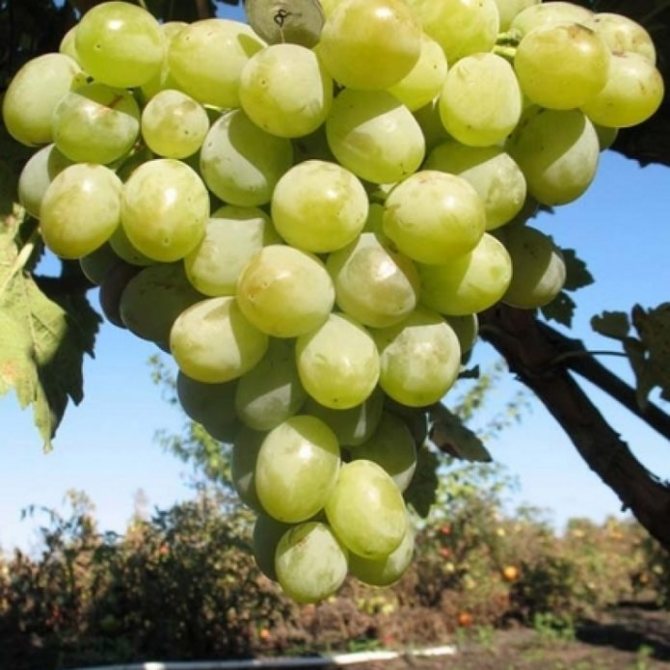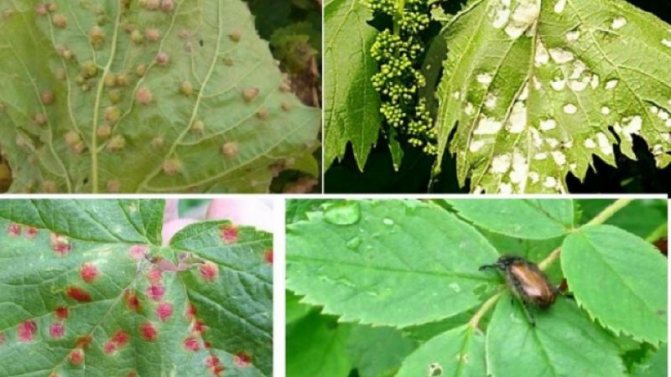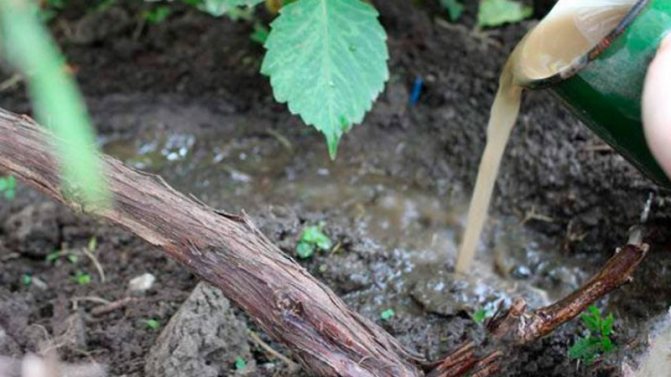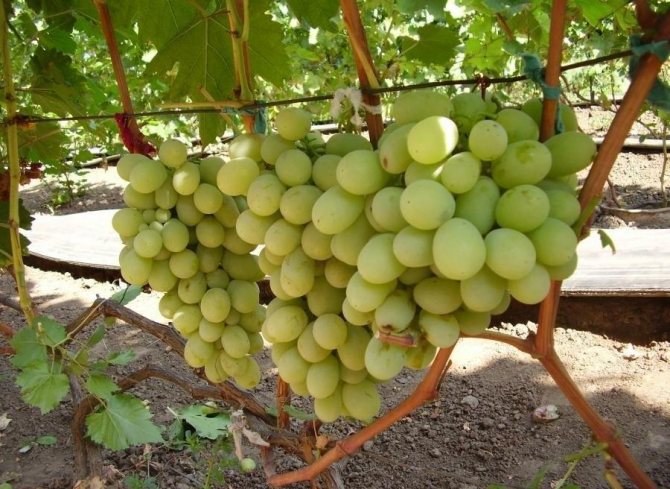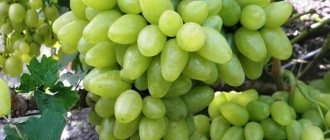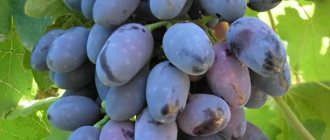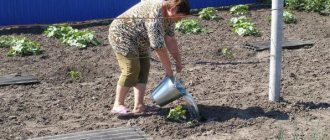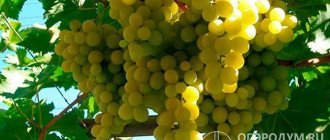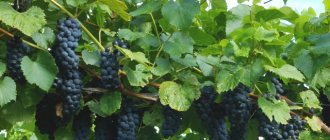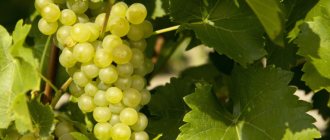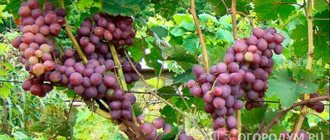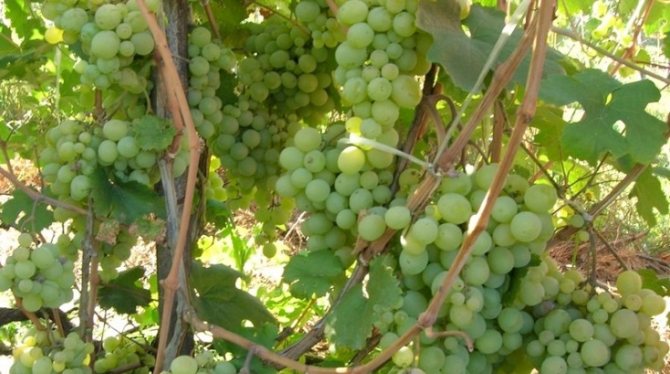
An excellent decoration for a festive table and a favorite delicacy of adults and children is Kesha grapes. The description of the variety will now be presented to your attention. These berries are very tasty and healthy.
There are varieties that, thanks to their excellent organoleptic and technical properties, are popular with consumers and people who grow grapes. These varieties include the Kesha grape in all its varieties. It is a white table variety with large and beautiful berries and a harmonious taste. The mere description of Kesha grapes makes you want to buy seedlings of this variety for your site, or at least buy a couple of large bunches for treating relatives and friends.
Description of Kesha grape varieties
Externally, the Keshi vine is practically no different from any other grape variety. Lignified shoots are light brown, young ones are light green. The length of the shoot itself (or vines) of this variety reaches 20 m. But this is a record figure. Usually, in the gardening of the middle lane, short vines with a length of no more than 3-4 m are used.
The leaves are three- or five-lobed, up to 15 cm in diameter, located on petioles up to 7 cm long. The arrangement of the leaves is alternate. The tendrils of Kesha grapes are of medium length, up to 3 mm thick.
The flowers of the variety are bisexual (except for the base hybrid, in which they are exclusively female). The flowers themselves are small, greenish, collected in a panicle-shaped inflorescence. Flowering occurs in early to mid-May.
Brushes have different shapes, there is no single standard. But most often they are conical or shapeless, in rare cases - cylindrical. The weight of one bunch can reach up to 900 g.
The fruits are large enough. Their weight ranges from 9 to 14 g. At the same time, the dimensions are impressive - up to 33 by 29 mm. Color - yellow-green.
Photo of Kesha grapes:
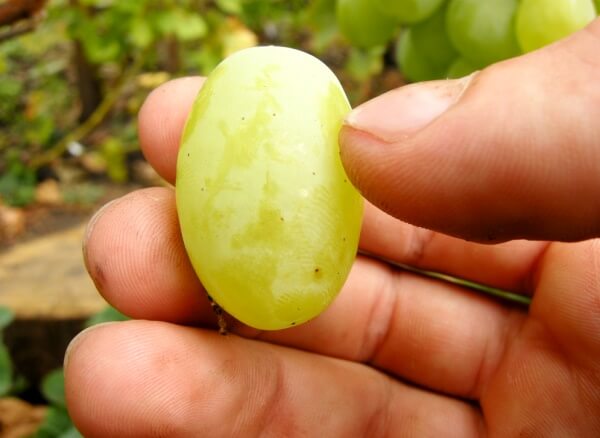

The taste of the fruit is characteristic, sweet. The berries are quite dense and fleshy. The sugar content is moderate - on average 22%, rarely reaching 25%.
According to the originator, Kesha grapes are able to withstand frosts down to - 22 ° C without any additional measures. Based on this, grapes are recommended for cultivation in areas belonging to the 6-7 frost resistance zones without shelter.
Several varieties were created almost simultaneously with the main hybrid. Consider a detailed description of these varieties of Kesha grapes:
Kesha grapes 1
Other names for this variety are Super Kesha, aka Talisman. The main differences from the original hybrid lie in the weight of the grapes and the number of fruits per cluster. The mass of berries can be up to 15 g, and brushes - about 1.1 kg.


Kesha grapes 2
Other names are Zlatogor, Muscat, Tamerlane. It is the result of hybridization of Kesha 1 and one of the Kishmish varieties. It also differs in the mass of berries, the brush is even heavier than that of Kesha 1, its weight reaches 1.2 kg. When ripe, the color changes to amber. The rest of the characteristics, including the ripening time, are identical to the original.
Kesha grapes red
This Kesha grape is actually a Kesha 1 variety, but has a pink fruit color when ripe. There are no other differences.
Grape Kesha Radiant
A variety of Keshi 2, which has an even greater hand weight, up to 2 kg. The color of the berries is darker than the original variety. There is a barely noticeable bloom on the berries.
Description of grape variety Kesha Talisman
There are no external differences between vines and leaves from the original hybrid. Its berries are slightly larger, which leads to an increase in the weight of the bunches by about 100 g. In addition, the ripening period occurs a month later. The average fruiting period is about 135 days.
The color of the berries can vary, towards a more saturated yellow color, however, it does not reach amber. Sometimes, according to gardeners, in the Kesha 1 grape variety, the skin is thickened, but botanists attribute this to the peculiarities of care, not linking it with varietal differences.
Also, Kesha 1 is more resistant to disease. Other characteristics: taste, color, sugar content and others completely repeat the original.
Variety characteristics
In general, the variety has balanced characteristics and can be recommended for cultivation as a fairly unpretentious crop.
Drought resistance, frost resistance
The drought resistance of the Kesha variety corresponds to the average resistance of the grapes, that is, irrigation breaks of up to one month are allowed. This is due to the well-developed root system of the plant, capable of reaching water from great depths.
Frost resistance may vary depending on the variety. The original Kesha tolerates frosts down to - 22 ° C. Hybrid Kesha 1 - up to - 26 ° С. With shelters in the form of agrofibre and 20-30 cm of foliage, both hybrids are able to withstand frosts down to - 35 ° С.
Productivity and fruiting
Fruiting in the Kesha variety lasts about two weeks. This is an early ripening variety, the berries ripen on it in an average of 3.5 months after the start of the growing season.
Ripening time depends on the intensity of care:
- from 95 to 110 days with intensive care and a sufficient number of sunny days;
- 100 to 105 days under normal growing conditions;
- no more than 124 days - the maximum allowable period.
The length of grape shoots ranges from 3 to 1.5 m. On average, one shoot accounts for up to 1.6 brushes. One bush can have up to a dozen shoots, thus, the yield from one bush is from 6.5 to 10 kg, which corresponds to an average yield of 3.5 kg per 1 sq. m.
These are averages. In fact, the yield depends on the degree of branching of the bush, the number of shoots per running meter of the trellis, the intensity of growth, illumination and feeding. Each of these factors has its own degree of influence on the overall yield.
The influence of weather conditions, however, is not prevalent. The hybrid was originally created for a temperate climate and within this framework it is rather difficult to influence its yield.
The berries do not crack in the sun and do not crumble, reaching full ripeness. Clusters and grapes are strong enough and not prone to deformation.
Scope of the fruit
It is a table variety intended for fresh consumption. It can be stored for a relatively long time in the refrigerator (up to 1 week) and transported over long distances.
This variety is not used for making wine or raisins. It is also not used for canning or juicing. This is explained by the lack of the required concentration of various substances contributing to the described procedures. Without them, neither wine nor juices will have the necessary "grape" taste.
The small number of seeds does not allow the use of Kesha grapes for cooking oil.
Disease and pest resistance
In fact, Kesha grapes are resistant only to some types of mold. Other diseases inherent in grapes may not bypass it.
Advantages and disadvantages of varieties
Consider the pros and cons of Kesha grape varieties.
Advantages:
- excellent taste;
- relatively high yield;
- ability to long-term storage;
- sufficient frost resistance;
- early ripening.
Disadvantages:
- vulnerability to most diseases (except Kesha 1);
- inability to use in home winemaking.
However, the latter is a rather difficult disadvantage, since table varieties are a priori not intended for making wines.
Diseases and pests
The Kesha variety is resistant to mildew, but can be affected by powdery mildew or powdery mildew. This fungal disease spreads quickly and is characterized by a grayish downy hair on the leaves. As if someone sprinkled the grapes with ashes. Affected bunches cannot be used for food and processed, they can only be destroyed in order to avoid the spread of infection. They fight powdery mildew by spraying the vineyard with fungicides. A good effect is given by the treatment of bushes with sulfur vapor. Correct crown formation and good ventilation of the vineyard will prevent disease.
Botrytis is another vineyard-damaging fungus that causes a disease called gray rot. It affects leaves, stems, inflorescences, berries. The provoking factor is a warm and humid summer, unharvested fallen leaves and berries, thickened vineyard, lack of pruning. Gray rot most often develops on weakened plants, spores are carried by the wind. On the leaves, the disease manifests itself with brown spots, the shoots turn brown, discolor and become covered with a gray coating, the flowers wither and fall off, the berries darken, dry out, and subsequently die off. From the fungus, preventive treatment with fungicides is carried out, during the formation of bunches and after leaf fall. To do this, use means such as Fundazol, Topaz, Topsin-M. Sprayed with solutions of copper sulfate and potassium permanganate, some use soda for this purpose.
Grape planting rules
The Kesha grape variety can be planted in two ways: either with a rootstock or with a seedling. The originator recommends the use of the first method to accelerate the fruiting process, however, the grapes have a high vegetation rate, so this is not critical.
Recommended timing
Planting can be carried out in the spring, when the air warms up to a temperature of at least + 15-20 ° С. Planting is allowed in the fall, but the following conditions must be met:
- it must be completed by the end of September;
- for the winter, the seedling will have to be covered in any case, regardless of the severity of the weather conditions.
Choosing the right place
The grapes love sunny places. The groundwater level should be no closer than 1.5-2 m from the surface. The root system of grapes can reach great depths, and excessive moisture can destroy the plant.
Important! In no case should you plant Kesha grapes in the shade. This is a southern crop with long ripening periods and an urgent need for sunlight.
Selection and preparation of planting material
Usually, seedlings with a developed root system and 1-2 generative buds are chosen. No preliminary preparation is required for Kesha grapes.
Landing algorithm
Planting is carried out in pre-prepared pits, which are pulled out six months before and filled with humus or compost by a third.
The depth of the pits is about 30-50 cm, and their diameter is 40-50 cm. The pits are located at a distance of at least 1.5 m from each other.
The seedling in the pit is placed so that its root collar is 5 cm above the ground level.
A support is placed next to the seedling, to which it is immediately tied. In the future, additional supports or trellises are arranged around this support.
The planted seedlings are covered with soil and irrigated with warm water in an amount of up to 30 liters for each bush.
Testimonials
Alexander, 37 years old. Sochi
The warm southern climate and the presence of a fairly large plot of land pushed me to grow grapes. As a beginner in this business, I decided to experiment with varieties. I got myself Kishmish, Transfiguration, Arcadia and Kesha.In general, my plantings brought a solid harvest and, accordingly, profit.
However, this summer, most of the bushes fell ill with mildew, the harvest was threatened. It was Kesha who saved me, who, as it turned out later, has a high immunity against this ailment.
Vladislav, 29 years old. Irkutsk
There are several varieties of grapes growing on my garden plot. But most of all I am pleased with the Talisman, it seems it is also called Kesha. On the bushes, voluminous clusters and juicy tasty berries always ripen. The whole family is happy with the results of my gardening work.
Follow-up care of grapes
Kesha grapes are irrigated up to 4-5 times per season. In this case, up to 50 liters of water are used, depending on the degree of growth of the bush. The conditional calculation formula is about 5 liters for each large shoot extending from the main branch.
Top dressing of Kesh grapes includes the following activities:
- The first top dressing is applied at the beginning (not covered grapes) or at the end of May. These are nitrogenous fertilizers, both organic and mineral. In the first case, up to 10 kg of rotted manure under one bush, followed by watering, in the second - saltpeter or urea in an amount of 20 g per 1 sq. m.
- A month after the first feeding, the second is introduced - phosphoric. This can be, for example, nitrophoska in an amount of up to 50 g per sq. m.
- A month later, potash fertilizers are applied. They are best applied foliarly by spraying the bottom row of leaves. Usually, their doses depend on the manufacturer and are indicated by them on the package.
The rest of the care conditions are the same as for any other grape variety.
Pruning grapes
Consists of two types: sanitary and formative.
The first is used after wintering grapes, especially when it is sheltered in frosty regions. Its purpose is to remove diseased, dry and damaged branches that appear after wintering.
Formative consists in the correct formation of the vine, its placement on trellises or other supports in order to make the most efficient use of all available space. Usually, up to 5 layers are made from the main branches, thus, getting from actually 2-3 large shoots emerging from the root, up to 15 shoots on trellises.
Branches of the second order are quite rare, and the third order is not allowed in principle.
Protecting crops from birds and insects
The large grape fruits attract birds, in particular starlings. Various ratchets and scarecrows do not have a sufficiently effective effect, therefore it is recommended to snatch the trellises with grapes with a fine-mesh (no more than 20 by 20 mm) fabric or nylon mesh.
The main pest of grapes is the small phylloxera insect. Although it does not feed on fruits, it does the maximum damage to the plant, destroying its roots. Usually grapes are prophylactically treated for phylloxera with insecticides and insect repellents. This protection is enough to ward off other uninvited arthropod guests.
Preparing culture for winter
In warm climates (6-7 frost resistance zones), preparation for winter is not required. If during winter the temperature drops below -22 ° C, it is necessary to remove the vine from the trellises and cover it with agrofibre or polyethylene, followed by adding a layer of foliage to 30 cm on top.
Breeding methods for grapes
Reproduction is carried out by all available methods. You can also get individual seedlings using cuttings and cuttings.
Attention! In fact, it doesn't make much of a difference how Kesha grapes are propagated given their high growth rate and incredible survival rate.
It is recommended by the originator to use the Kesha stalk as a rootstock for any old, but still strong enough grape bush. In fact, this will save 1-2 years in cultivation, however, some advanced seedlings give a similar result.
How to choose the right seedlings
We recommend buying seedlings of the future vineyard only in special proven nurseries or garden centers. Professional staff will help you choose strong and healthy planting material. When choosing, pay attention to the roots and leaves of the seedling. The roots should not be overly dry. This can be verified by cutting a small portion of the root. For a good, not dry root, the middle should be light.
Leaves and vines should be free from damage and signs of disease. Otherwise, the seedling will not accept well in a new place during transplantation and will constantly hurt. The day before the intended planting of grapes, the seedling does not need to cut the roots a lot and place it in a special solution of a growth stimulator. It will contribute to the quick and painless establishment and rooting of the seedling in a new place.
IMPORTANT: when choosing a seedling, first of all, evaluate the condition of the root system for the absence of root rot. Do not buy planting material in closed containers.

